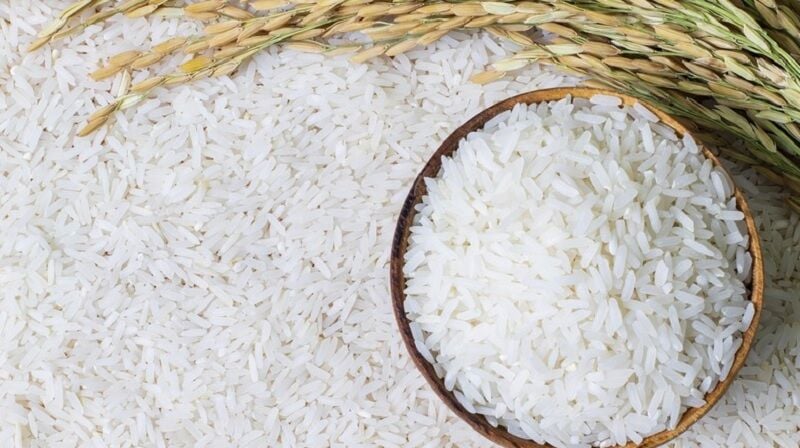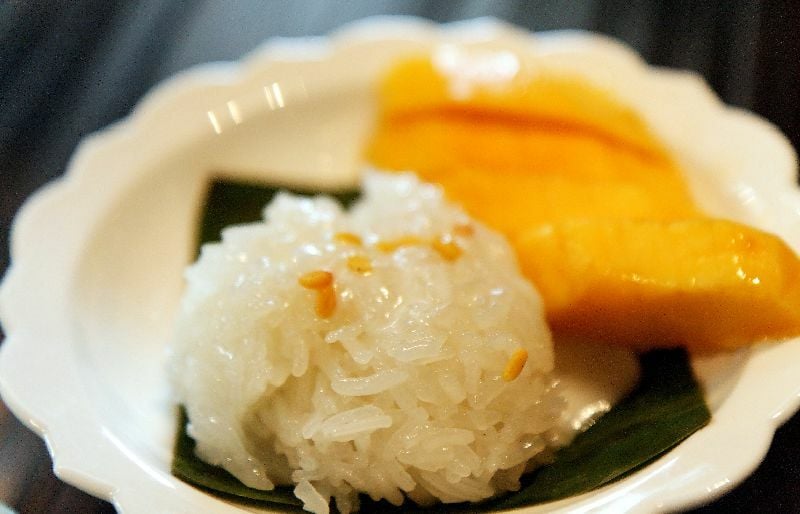Explore the different types of rice in Thailand

Thailand is establishing itself as a prominent leader in the rice industry, providing a diverse range of high-quality varieties upon which many countries depend. Understanding rice in Thai culture and cuisine is crucial before exploring the specifics.
In Thailand, rice transcends the boundaries of mere sustenance to represent a cultural ethos. The expression “kin khao,” which signifies to eat, literally means “eat rice,” underscoring its fundamental role. From aromatic jasmine rice to sticky rice accompanied by sweetened coconut milk, the diversity of rice types. Whether it is round rice noodles influenced by Mon settlements or the vibrant yellow rice, each variety offers distinct flavours and cultural significance.
What are the rice varieties in Thailand

Jasmine rice (Khao hom mali)
Jasmine rice, famously known in Thailand as Khao Hom Mali, is a culinary superstar and a cultural gem in Thai cuisine! Imagine the aroma of pandan leaves and the delightful scent of popcorn – that’s the magic of jasmine rice, thanks to the amazing compound 2-acetyl-1-pyrroline. This extraordinary, long-grain rice, native to Thailand, is an essential ingredient that elevates curries, stir-fries, and soups. The incredible, fresh aroma of jasmine rice is something to cherish, even though it gently fades over time.
Nutritional benefits Jasmine rice doesn’t just smell and taste amazing; it’s also great for you. It’s full of carbs that give you energy and has a nice amount of protein and fibre. If you choose brown jasmine rice, you’ll get even more fibre, which is awesome for digestion.
Cooking tips To achieve the perfect Jasmine rice, rinse it under cold water until the water runs clear. This removes excess starch, preventing it from becoming too sticky. Use a rice cooker for convenience or the stovetop method with a 1:1.5 rice-to-water ratio. Let the rice rest, covered, for about 10 minutes after cooking to allow the grains to firm up.
Thai Coconut Rice: Treat yourself to this sweet serenade of Jasmine rice crooning with coconut milk and sugar. It’s the star sidekick for any savoury hero. Khao Tom (Rice Soup): Enjoy a big bowl of edible hugs and Cooked Jasmine rice snuggled up with tender chicken and Thai herbs, all swimming in a comforting, soothing broth.
Jasmine rice pairs beautifully with various Thai dishes, from spicy curries to stir-fries. Its subtle aroma and soft texture highlight the bold flavours of Thai cuisine, making it a versatile base for both main courses and side dishes.
Thai sticky rice
Thai sticky rice, also referred to as glutinous rice, is highly regarded for its application in exquisite desserts and snacks. To commence preparation, the rice must be soaked for several hours before cooking. Utilizing either a rice cooker or boiling method is acceptable, maintaining a ratio of 2 cups of water per 1 cup of rice. Ensure the lid remains securely fastened for a minimum of 10 minutes after water absorption to achieve the desired sticky consistency. For an even more cohesive texture, refrigerate the covered pot for 1-2 hours post-cooking. This method optimizes the rice for use in a variety of delectable culinary creations.
Thai sticky rice, also known as glutinous rice, holds a significant place in Thai cuisine due to its distinctive sticky and chewy texture. This texture arises from its high amylopectin content. Unlike other types, Thai sticky rice grains are long and opaque, slightly thicker than Jasmine rice grains. To achieve the perfect texture, sticky rice needs to be soaked in water for several hours before being steamed in a special basket or pot.
Nutritional benefits of sticky rice Containing essential nutrients, sticky rice offers numerous health benefits. It’s a good source of energy, and its nutrient profile includes vitamins like B3 (Niacin) and D. Unlike refined grains, the intact layers of sticky rice preserve its nutritional content. Including sticky rice in your diet can enhance nutrient intake without sacrificing taste.
Delicious recipes with Thai sticky rice

Thai sticky rice is like the culinary Swiss Army knife whether you’re craving sweet treats or savoury sensations.
Mango Sticky Rice: Imagine sticky rice, fresh mango slices, and a drizzle of coconut milk getting together for a tropical party in your mouth. First, let the rice soak in a tub (4-6 hours, it’s on vacation), then steam it like it’s in a spa. Marry the steamed rice with sweetened coconut milk and plop some ripe mango slices on top, and voila, you’ve got yourself a dessert that’s dressed to impress. Sticky Rice Dumplings: Think of these as the Swiss rolls of the savoury and sweet world. whatever floats your boat—red bean paste if you’ve got a sweet tooth, or marinated pork if you’re feeling savoury. Soak, steam, and stuff, and suddenly, you’re everyone’s favourite chef. Larb-Inspired Sticky Rice: Sticky rice is the wingman your spicy and tangy Larb salad always needs. It’s like pairing Batman with Robin, providing a sidekick that’s essential for soaking up all those robust flavours.
Whether front and centre on your plate or playing a supporting role, sticky rice brings that irreplaceable texture and flavour that make Thai cuisine unforgettable.
Black rice (Khao dum)
Black rice, known as Khao Dum in Thailand, is starting to get noticed for its unique look and awesome nutritional benefits. Back in the day, it was considered a luxury and even called “forbidden rice” because it was so rare. You’ll often find it in desserts and health recipes, adding a cool contrast with its dark colour and slightly nutty taste.
Black rice, with its fashionably deep, purplish-black attire, is the superhero of the grain world, loaded with anthocyanin antioxidants. It struts around with a slightly chewy texture and a nutty flavour, making both sweet and savoury Thai dishes swoon. This recipe you can’t miss is Black Rice Pudding with Coconut Milk. It’s like a color-bomb in your bowl. Just cook the black rice, and mix it up with some coconut milk, sugar, and a sprinkle of salt, until it turns into a luscious pudding. You can enjoy this dish either warm or chilled.
For something fresher, meet Black Rice Salad. Just toss some cooked black rice with finely chopped veggies, herbs, and a zesty dressing made from lime juice, fish sauce, and chilli. This salad is like a breath of fresh air in your lunchbox, refreshing and nutritious, perfect for a light lunch or a whimsical side dish.
Brown jasmine rice
Brown Jasmine rice maintains the fragrance of white Jasmine rice but includes the bran layer, providing higher fibre content. It’s slightly chewier and more nutritious. Cook this rice using a 1:2 ratio of rice to water, simmering it for about 35-40 minutes, resulting in a tender yet slightly chewy texture, perfect for health-conscious dishes.
Red cargo rice
Red cargo rice is a variety of non-glutinous long-grain rice characterised by its red bran layer. This rice exhibits a lower level of stickiness compared to Jasmine and sticky rice. Its nutty flavour and chewy texture render it a suitable accompaniment to a variety of Thai cuisine. To properly prepare red cargo rice, employ a 1:2 ratio of rice to water. It necessitates a longer cooking duration than white rice, specifically around 35–40 minutes of simmering.
Nutritional benefits Red rice is like the superhero of the grain world, bursting with fibre, antioxidants, and essential minerals like iron and zinc. It’s the Clark Kent to white rice’s plain old newspaper reporter. That fabulous reddish hue? It’s all thanks to anthocyanins, the same stuff that makes berries superstars at fighting off oxidative stress.
Cooking methods Cooking red rice is like taming a wild Mustang compared to the lazy stroll of cooking white or Jasmine rice. You can soak it for at least two hours, think of it as a pre-cooking spa day. Then, it’s 2.5 cups of water to 1 cup of rice dance, simmered on low heat till the grains are tender but retain that al dente sass. This careful method keeps all the good stuff intact and makes sure your rice has the right amount of chewiness.
you can also check out foods that are bad for your skin, High-glycemic food digests easily and shoots your blood sugar up like a rocket. This spike can make your skin start pumping out more oil, which might lead to breakouts. These foods also speed up the ageing process, causing early wrinkles and making your skin less plump and youthful.
Latest Thailand News
Follow The Thaiger on Google News:


























